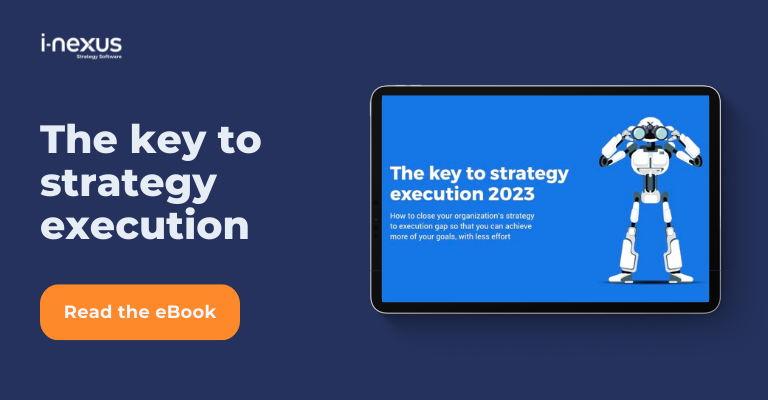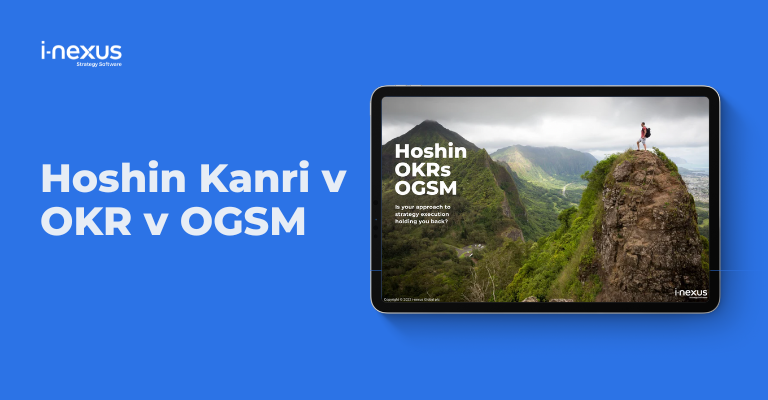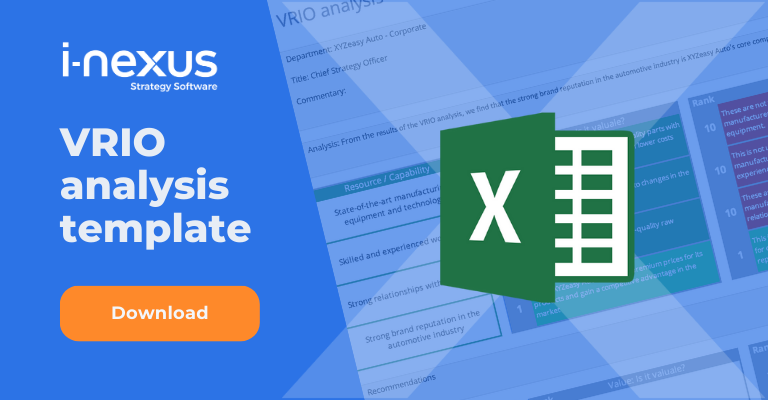In need of a strategic management tool? We've identified five powerful strategic management tools you need to use right now.
Written by: James Milsom, Head of Marketing
Strategic management is the key to achieving your business goals. It involves setting objectives and analyzing the environment of your sector to help implement initiatives to fulfill your business’ strategy.
Making use of strategic management tools can help you organize your processes and track performance.
You can use these tools to determine precisely where your organization is going in the next few years and beyond and how to get there.
Here, we’ll dive into the five best strategic management tools to help you develop your corporate strategy and meet your goals.
What do strategic management tools do?
Strategic management tools can help your business determine where it’s at right now, where it’s heading, and what metrics and initiatives need to be tracked to get there. Their benefits include:
- Improved collaboration
Strategic management tools can lead to more solidarity within your organization. They can provide a framework for strategic decisions that all employees can rely on. This can create greater harmony and collaboration amongst employees, as you’ll all be on the same page. - Competitive advantage
Using strategic management tools can offer you a competitive advantage in your industry. They offer valuable insight into your business’ strengths and weaknesses so you know what changes you need to make to stay ahead of your competitors. - Prepared for change: Strategic management tools can help you adapt to changes within your business. They can also help you plan for any potential disruptions by anticipating potential threats and helping you put together an action plan to deal with these changes.
Strategic management tools play a key role in closing your strategy-to-execution gap.
Here are some powerful strategic marketing tools
We’ve covered what strategic management tools do and some of their key benefits. Next, we’ll dive into some of the most powerful strategic marketing tools you can use to improve your approach to strategic management.
SWOT analysis
SWOT analysis is an internal tool that your business can use to evaluate your internal and external strengths and weaknesses and your competitive position.
SWOT is an acronym for “strengths, weaknesses, opportunities, and threats.”
The first two components, strengths, and weaknesses, look at internal factors within your business, whereas the latter represent external factors that may impact your company.
Let’s look at what each component refers to and how they can be used to measure your opportunities and weaknesses:
- Strengths
Here, you’ll look at what your company is good at and what makes you stand out against your competitors. What do you do well? What do others (such as your clients or customers) see as your top strengths? Perhaps you have unique technology or a strong brand image, for example. - Weaknesses
This is where you assess what is stopping your company from performing at its best. You’ll need to be honest about what is holding you back as a company and where to improve to match or compete with your competitors. For example, maybe you have some supply chain issues that need resolving. - Opportunities
Next, you’ll look at factors your business can use to gain a competitive advantage. What opportunities exist for you to expand your business to compete in the market? For example, you may expand your business abroad to create more of a global brand, increasing your profitability. - Threats
Finally, you’ll need to identify what factors have the potential to harm your company’s success. Common threats include increasing competition and rising costs for materials.
You can then use the SWOT framework to assess what your business can and cannot achieve and what external or internal factors may help or hinder that success. SWOT analysis can help you take advantage of your business opportunities and mitigate potential threats.
OKR
First introduced to Intel in the 1970s by Andrew Grove, OKR stands for “objectives and key results.” They’re a way for your team to track progress and encourage engagement around setting challenging and realistic goals.
To set OKRs, you typically write an objective with three to five supporting “key results” underneath, which outline how the objective will be measured.
The objective you set is simply what you plan to achieve.
This objective should be action-oriented and inspirational, encouraging you or your employees to have something inspiring to work towards.
The key results you design should work as smaller goals you must tick off to achieve the overall objective.
Effective key results are specific, time-sensitive, and measurable, meaning there’s no gray area or room for negotiation - you either meet the requirements of the key result or you don’t.
With OKRs, you’ll usually set a period to review them every quarter to check whether the key results are met. Once completed, the objective has been achieved.
Learn more about OKRs and how you can use them alongside Hoshin Kanri in our eBook:
PESTLE analysis
Another tool for strategic management is a PESTLE analysis.
It’s one of the key strategic management tools to dive into the external factors that affect your organization and its success. Here are the different elements that make up a PESTLE analysis that may affect your business:
- Political
Political factors relate to how the government controls and influences can affect the economy or industry of your work. This may include employment law, taxation, and environmental regulations. - Economic
Economic factors such as interest, exchange rates, and inflation can affect your business' finances. - Social
Social factors explore the demographics and culture that impact the environment of your industry. Factors such as lifestyle choices, health, religion, and ethics or education can influence how a customer engages with your product or service. - Technological
Depending on your industry, technological factors may or may not affect you. Here, you’ll look at how technological innovations impact your business, such as technological advancements, automation, and your customers’ technological awareness. - Legal
Depending on your industry, legal factors may or may not affect your business. Legal and regulatory factors can influence the policies and procedures of your business. These include consumer laws, environmental regulations, and consumer protection. - Environmental
Environmental factors can affect your organization through weather conditions, climate change, and location. Environmental factors are likely to impact specific industries more than others, particularly tourism or agriculture.
Balanced Scorecard
Another powerful strategic management system that can help you achieve your business goals is known as balanced scorecard (BSC).
It encourages you to look at past performance data to help you make better, more informed decisions. Balancing strategic measures with traditional financial measures offers a more “balanced” view of your business’ performance - which is where the name comes from.
It can help you measure your business's intellectual capital, providing you with a competitive advantage.
To do this, you will gather your business data and information and look at it from four different perspectives: learning and growth, business processes, customer perspectives, and financial data.
A key benefit of the BSC is that it allows your business to gather all its information and data into one report to improve procedures and operations, saving your team time and resources.
It can also be part of a toolkit, including Hoshin Kanri.
By measuring the above metrics, you’ll gain insight into what your business is doing well and where you need to invest in your employees’ training to meet your goals.
Learn more about BSC with our guide.
VRIO framework
The VRIO framework is a great way to analyze your business’ internal resources and find your competitive advantage.
VRIO is an acronym for value, rarity, imitability, and organization.
You can use this tool to categorize your resources (such as financial resources, human resources, material or non-material resources) depending on whether they hold certain traits outlined in the framework:
- Value
Is the resource valuable and offers a benefit to your organization? - Rarity
If a resource is unique and not used by most other organizations, you can consider it rare. A rare resource gives you more of a competitive advantage in your industry. - Imitability
Is the resource hard to imitate? If so, it’s less likely your competitors will acquire it. This is usually if it’s protected by legal means such as trademarks. - Organized
Is the resource organized to capture value? This will be the case if your business's processes, structure, and culture support it. It’s unlikely that a resource will offer any competitive advantage to your company if it’s not organized to capture value.
Learn more about VRIO with our guide.
How could strategy software help here?
Strategic management tools are a great way for your business to assess its performance and competitive advantage.
But these goals can’t be achieved without a well-executed strategy. That’s where i-nexus can help you.
Our strategy execution software can help to streamline your processes and overcome any blockers that get in your way.
Think of it as more goals achieved, with less effort on your part.
Ready to discover the better way to deliver on your plans? Book a demo today and see how the i-nexus software can help get your whole team aligned on achieving your business goals.
Learn more about strategy execution
Click here to learn more about strategy execution or take a look at these content recommendations:
- Strategic Portfolio Management 101: Strategic Portfolio Management is becoming increasingly popular as more businesses look to optimize and improve their time to market, address their CAPEX, achieve their ESG targets, and realize their strategic goals - so what does it all mean?
- Strategic planning template pack: Download a copy of our Excel strategic planning template pack to help you with putting these tools and more to use in your strategy planning and execution
- The key to strategy execution: Read our eBook to help you implement a new strategic portfolio management plan, with advice on executing your projects successfully and avoiding common mistakes.
About the author
James Milsom is Head of Marketing at i-nexus. James has wide-ranging experience in telecommunications, energy, education, and software markets.
As Head of Marketing, his drive is to raise awareness and understanding of the challenges facing enterprises in delivering strategic objectives and transformation amidst changing markets and the obstacles traditional tools and methods present leaders.
If you’d like to talk more about Strategy Execution, contact James at james.milsom@i-nexus.com or connect with him on LinkedIn for the latest insights.






